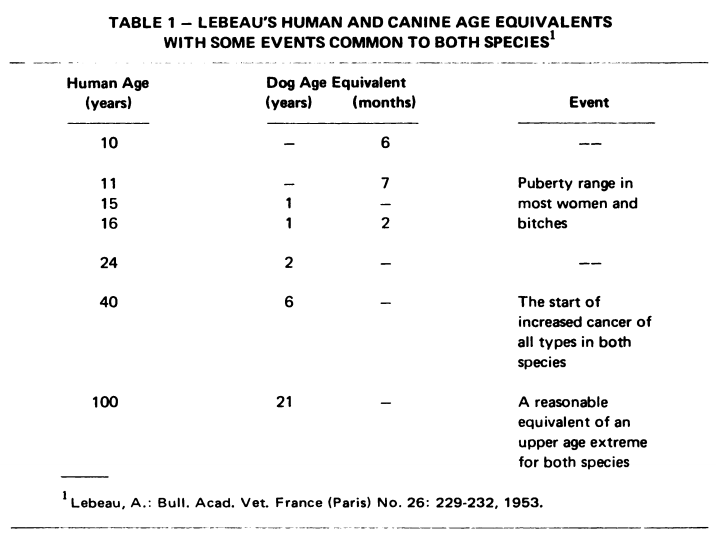
In 2008, when the world’s oldest reported dog — a 29-year-old labrador named Bella — passed away, Daily Mail wasted no time in sensationalizing the news: “The World’s Oldest Dog Dies at the Age of 203 (in Canine Years).” But in calculating the canine’s age, the paper relied on falsified “fact” that’s regurgitated more than chew toys: The notion that one “human” year is equal to seven “dog” years.
As The Wall Street Journal’s Carl Balik points out, if this ratio had any truth to it, humans would be capable of reproducing by age seven, and high percentages of us would live to be 150.
While the “seven-year rule” is nothing more than mythology, dog owners (and media outlets) continue to use it for its simplicity — it’s convenient, after all, to have a “one size fits all” method of understanding our pets’ equivalent stages of life. In reality, contextualizing a dog’s age is a bit more complex.
The “Seven-Year Rule”

The origins of the “seven year myth” are shrouded in mystery. An Judgment Day calculation inscribed at Westminster Abbey in 1268 declared a ratio of 9 to 1 — that is, humans live to age 81, and dogs to age 9. Georges Buffon, an 18th-century French naturalist, had more or less the same theory: Humans live to 90 or 100 years, and dogs to 10 or 12.
At some point in the 1950s, a rhetoric emerged that humans generally live 70 years, and dogs 10; simple and easy translate, this became a “ratio” of sorts for dog owners to calculate their pets’ human ages. From there, veterinarians likely espoused the “seven-year rule” as truth.
“My guess is it was a marketing ploy,” Kansas State vet William Fortney speculates in the WSJ. “It was a way to encourage owners to bring in their pets at least once a year.”
As this “rule of thumb” gained traction as a truth, researchers and gerontologists began to question its validity. In 1953, French researcher A. Lebeau categorized life-stage markers shared by humans and dogs — puberty, adulthood, and maximum lifespan — and established, for the first time, that dogs age 15 to 20 times faster than a human in their first year of life, then, as they age, gradually slow to a ratio of one to five (dog to human) years:
Lebeau’s original findings
Lebeau’s eventual conclusion: The age of a dog of one year is equivalent to a human being a 15 years; a dog of two years to a human of 24 years; and from the age of two years, each year of a dog’s life is equal to four human years. Subsequent studies sought to disaggregate this data further, by size, weight, and breed.
A Better Approach
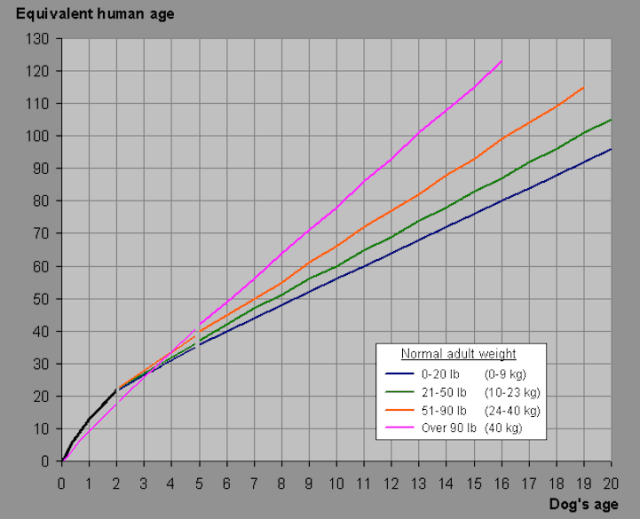
Approximate dog age versus human age correlation, allowing for differing sizes of dog; data via Wikipedia
So, what is the proper way to translate human years to “dog years”? It largely depends on the breed and size of the dog in question. As aging expert David J. Waters clarifies, “Eight years in one breed is not equivalent to eight years in another.”
Dogs can be categorized into four breed sizes: Small dogs (20 pounds or less; ex. chihuahuas, toy poodles), medium dogs (21-50 pound; ex. labrador retrievers, bulldogs), large dogs (51-90 pounds; ex. Afghan hounds, Irish setters), and giant breeds (over 90 pounds; ex. great danes). Each ages at a slightly different pace, and carries a different dog to human year ratio:
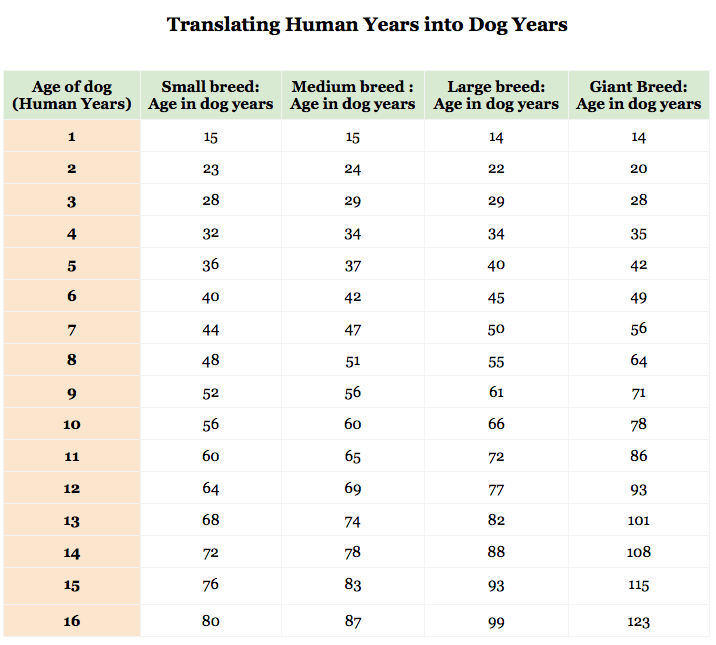
Small = less than 20 lbs; Medium = 21-50 lbs; Large = more than 50 pounds; Priceonomics, data via here and here.
Most research insinuates that giant breed dogs age more rapidly than other breeds. Evolutionary biologist Cornelia Kraus believes that this may have something to do with the growth hormone IGF-1, which small dogs, like toy poodles, have much lower natural concentrations of than larger dogs. Animals with lower levels of the hormone tend to have slower rates of aging, as well as reduced risks of age-related diseases.
In all, the age at which breeds generally become geriatric (or required special care due to old age), averages to 11 human years for small dogs, 10 years for medium dogs, 8 years for large dogs, and 7 years for giant breeds.
Still, the information above doesn’t tell the whole story. Researchers who have extensively tracked single breeds of dogs have found much different results. A 130-pound great dane or 200-pound Saint Bernard, for instance, might be the equivalent of 26 years old after only one year of life; in the same respect, an 11-pound miniature poodle may only be the equivalent of 10 years old in the same time span.
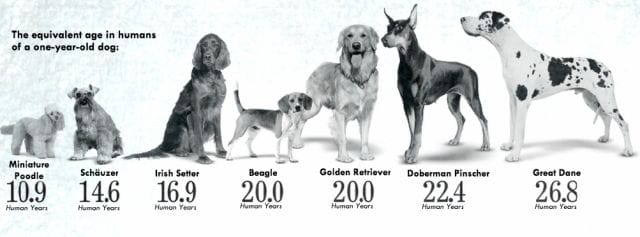
Source: The Wall Street Journal, Journals of Gerontology
There are also outliers — like the beagle — that tend to age at different rates than other dogs in its breed-size class. While independent studies have been conducted (you can read through an especially exhaustive one here), the reasons behind instances like this are still scientifically unfounded.
An Aside on Lifespans
In 1901, the average human lifespan in the United States was 49 years; today it is 77. Similarly, today’s dogs live much longer lives than their century-old ancestors (less than 20% of dogs lived past age six in 1900, as opposed to 44% in 2010).
Yet because there is no canine equivalent to the National Center for Health Statistics, we rely on a triage of sources for their lifespan data: pet insurance companies, breed-club surveys, and veterinary hospitals. As Carl Bialik of the WSJ notes, these sources often provide inaccurate, skewed results. Dogs who have insurance, for instance, are generally more likely to live longer lives. Surveys, which often require owners to guesstimate their pets’ ages, yield inflated numbers. Nonetheless, we can roughly estimate a dog’s lifespan based on its breed and size.
Generally, the more pint-sized the dog, the longer he tends to live (again, there are some exceptions):
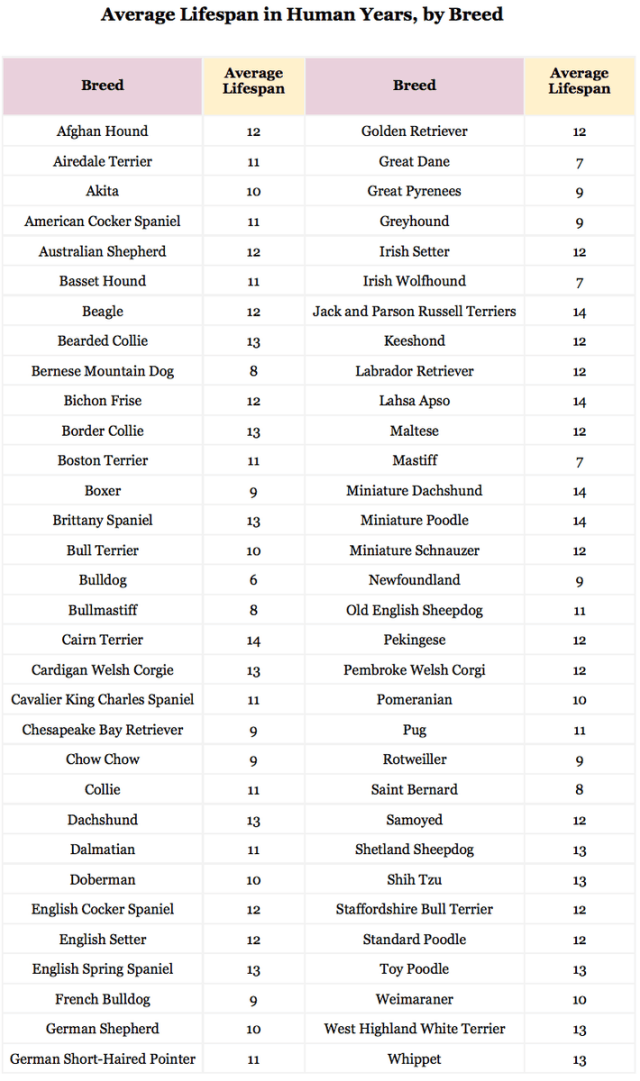
A glance through the oldest confirmed dogs in history seems to validate this:
The Oldest Confirmed Dogs in History
Data via Wikipedia, news archives
Max, the oldest verified dog of all time, was a terrier-dachshund-beagle mix (all small pure breeds), and weighed in at just 13 pounds. Out of the eldest 18, 15 (83%) were under 20 pounds.
While these stats are hardly conclusive (and, in some respects, yet to be scientifically explored), we hope they offer a more nuanced way to calculate your dog’s approximate “human age,” as well as his projected life span. At the very least, keep in mind that the “seven-year rule” espoused by the media is as worthless as the contents of a doggie-bag.
If you enjoyed this post, you’ll like our book → Everything Is Bullshit.
This post was written by Zachary Crockett; you can follow him on Twitter here. To get occasional notifications when we write blog posts, please sign up for our email list.




